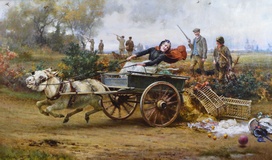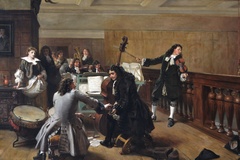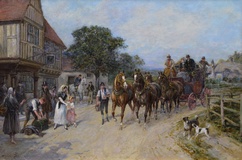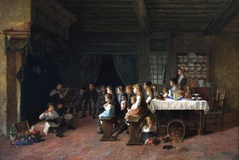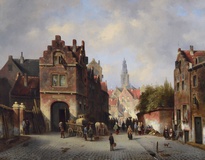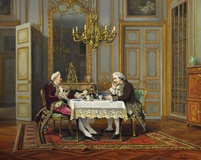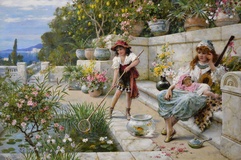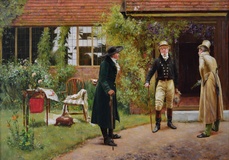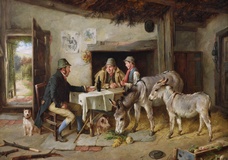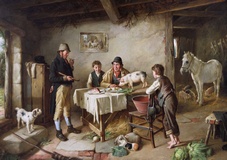William Stephen Coleman
British, (1829-1904)By the Fish Pond
Oil on canvas, signed & dated 1898
A beautiful painting by William Stephen Coleman of a woman with two girls in a semi classical style by a Mediterranean pond. The woman is depicted resting on a terrace with her young daughter asleep on her lap, whilst another child catches goldfish in a bowl. This tour de force would have most likely been painted by Coleman as an exhibition piece.
William Stephen Coleman was a figurative painter who was born in Horsham in 1829. He was one of 12 children born to a physician named William Thomas Coleman and his wife Henrietta (née Dendy). Three of his siblings Rebecca Coleman (b1837), Helen Cordelia Angell (1847–1884) and George Coleman also became artists, inheriting their artistic talent from their mother’s side of the family. Coleman developed an interest in nature from an early age, producing drawings as a hobby. Despite his ability, he initially followed in his father’s footsteps and trained as a surgeon. However, this proved unsuccessful and by the age of 21 he had turned back to art, later gaining employment with the Dalziel Brothers, a firm of wood engravers who specialised in natural history illustrations.
Sometime during the late 1850’s he moved to London where he married his first wife Henrietta Augusta Boultbee in 1858. Around the same time, he began producing illustrations for books; the first of which was entitled ‘Common Objects of the Country’ and published in 1858. He subsequently published two of his own books ‘Our Woodlands. Heaths, and Hedges’ in 1859 and ‘British Butterflies’ in 1860. After the death of his wife in 1860, his sister Rebecca and brother George went to live with him in Garway Road, Paddington. Rebecca would often assist him with the wood blocks for his illustrations.
As well as working as an engraver, he also began producing classically influenced paintings featuring figures in landscapes. Initially these were executed in watercolours but later extended to oil paintings. He began exhibiting at the Dudley Gallery in 1865 and was one of the original committee members. He continued to exhibit there until 1879 and was a committee member up until 1881.
By 1869, he had also begun to work on pottery decoration and in 1871 was asked by Minton’s to establish an Art Pottery Studio at Kensington Gore. Whilst at Minton’s, he produced figure designs for their ceramic ware. His sister Rebecca also worked at Minton’s and they moved to Belle Vue in Chelsea to be closer to the studio. From 1881, he lived at 3 St John’s Wood Studios, Queens Terrace in Paddington and in 1888 moved to 43 Broadhurst Gardens in Hampstead. In 1893 one of his classically inspired works ‘The Gold Fish Bowl’ was reproduced in the Pears Christmas annual leading to a surge in popularity and a demand for his work. Another two of his paintings subsequently appeared in the annual over the years. He married his second wife Emma Felldon in 1898 and the couple later moved to 57 Berners Street, Marylebone. He died on 22 March, 1904 at St John’s Wood.
Examples of his work are held at the Glasgow Museum, Metropolitan Museum, New York, Museum of Croydon, Victoria Art Gallery, Bath as well as the V&A.
© Benton Fine Art
| Presentation | The painting is housed in a new, English made gilt frame which is in excellent condition. |
| Condition | As with all of our original antique oil paintings, this work is offered in ready to hang gallery condition, having been professionally cleaned, restored and revarnished. |
Dimensions
| Image Size | 23 inches x 35 inches (58.5cm x 89cm) |
| Framed Size | 30.25 inches x 42.25 inches (77cm x 107.5cm) |
You May Also Like













